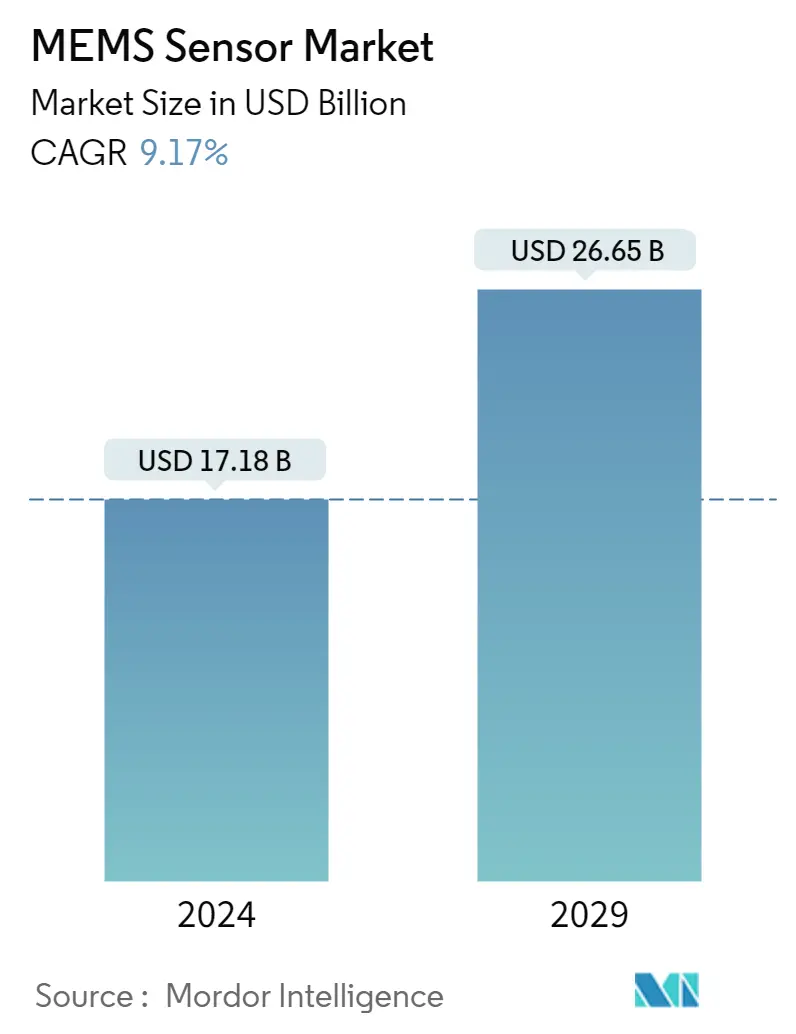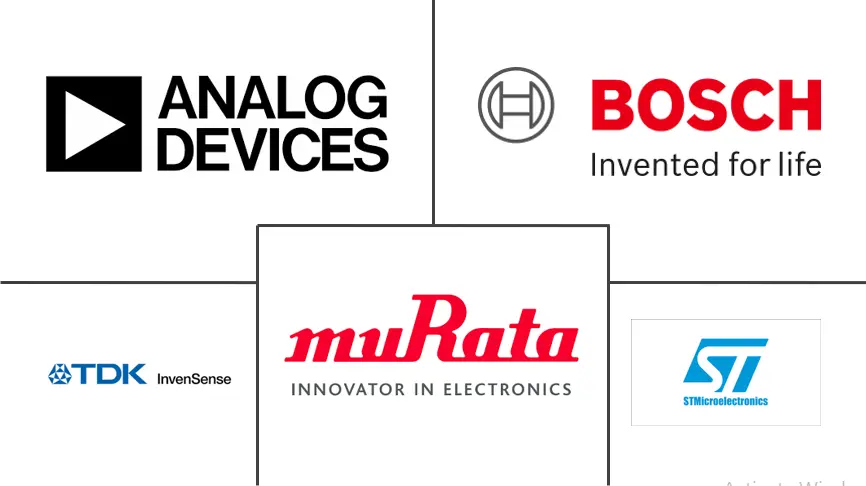Market Size of MEMS Sensor Industry

| Study Period | 2019 - 2029 |
| Market Size (2024) | USD 17.18 Billion |
| Market Size (2029) | USD 26.65 Billion |
| CAGR (2024 - 2029) | 9.17 % |
| Fastest Growing Market | Asia-Pacific |
| Largest Market | Asia-Pacific |
Major Players
*Disclaimer: Major Players sorted in no particular order |
MEMS Sensor Market Analysis
The MEMS Sensor Market size is estimated at USD 17.18 billion in 2024, and is expected to reach USD 26.65 billion by 2029, growing at a CAGR of 9.17% during the forecast period (2024-2029).
The rising popularity of IoT in semiconductors, the growing need for smart consumer electronics and wearable devices, and the enhanced adoption of automation in industries and residences are some significant factors influencing the growth of the studied market.
- MEMS sensors deliver multiple advantages, such as accuracy, reliability, and the prospect of making smaller electronic devices. As a result, they have gained considerable traction in the past few years. Miniaturized consumer devices, such as IoT-connected devices and wearables, are emerging applications of MEMS sensors in the market.
- According to the IFR forecasts, global adoption is expected to increase significantly to 518,000 industrial robots operational across factories all around the globe in the next few years. The positive growth trajectory of the industrial robots market is expected to drive the demand for MEMS sensors during the same period.
- Moreover, the demand for smartphones has been witnessing an upsurge owing to several factors increasing disposable income, the advent of 5G, and the development of telecom infrastructure. For instance, according to Ericsson, worldwide smartphone subscriptions are expected to reach 7,690 million in the next few years.
- Furthermore, pressure sensors are anticipated to witness the fastest growth rate as they are used in numerous application areas, such as biomedicine, automotive electronics, small home appliances, and wearable and fitness electronics. Other MEMS sensors, such as microphones and ultrasonic MEMS sensors, environmental sensors, and microbolometers, are expected to hold a significant share of the market studied.
- The US-based Boston Semi Equipment (BSE), a semiconductor test handler company, recently received repeat orders from automotive customers for multiple Zeus gravity test handlers configured for MEMS high-power and pressure IC testing applications. Zeus handlers have a flexible range for MEMS pressure sensing test cells and offer high voltage levels in a production handler for testing IGBT, MOSFET, gate drivers, GaN, and SiC power semiconductors.
- In addition, the factors challenging the market's growth include the increase in the cost of MEMS sensors implementation due to interface design considerations and the lack of a standardized fabrication process of MEMS. The standardization in MEMS is undoubtedly less advanced than it is for conventional semiconductor processes and model environments. However, the standard procedure is bound to happen in the next few years, making the impact of the challenge gradually low in the next few years.
- Due to the COVID-19 pandemic, certain types of MEMS sensors significantly spiked in demand. For instance, the demand for thermopiles and microbolometers used in temperature guns and thermal cameras increased because of the need for contactless monitoring of people's temperatures. Moreover, real-time polymerase chain reaction (PCR) diagnostic tests for detecting COVID-19 and microfluidics for DNA sequencing gained substantial market relevance.
- Furthermore, pressure and flowmeters in ventilators grew because of hospital intensive care units (ICUs). Therefore, the pandemic highlighted the criticality of having a robust healthcare infrastructure, and the industry's subsequent developments are expected to propel market demand over the forecast period.
MEMS Sensor Industry Segmentation
MEMS sensors gather data by analyzing environmental parameters by measuring thermal, magnetic, mechanical, and optical phenomena. These sensors have various applications in numerous sectors, such as automotive, healthcare, consumer electronics, industrial, aerospace, and defense. These have formed part of the study in considering the end-user industry estimation.
The scope of the study is also focused on different MEMS sensor types, such as pressure sensors and inertial sensors, among multiple geographies. The impact of COVID-19 on the market and impacted segments are also covered under the scope of the study. Furthermore, the disruption of the factors affecting the market's expansion in the near future has been covered in the study regarding drivers and restraints.
The MEMS sensor market is segmented by type (pressure sensor, inertial sensor), end-user industry (automotive, healthcare, consumer electronics, industrial, and aerospace and defense), and geography (North America, Europe, Asia-Pacific, and the rest of the world).
The market sizes and forecasts are provided in terms of value (USD million) for all the above segments.
| By Type | |
| Pressure Sensors | |
| Inertial Sensors | |
| Other Types |
| By End-user Industry | |
| Automotive | |
| Healthcare | |
| Consumer Electronics | |
| Industrial | |
| Aerospace and Defense |
| By Geography | |||||||
| |||||||
| |||||||
| |||||||
| Rest of the World |
MEMS Sensor Market Size Summary
The MEMS sensor market is poised for significant growth, driven by the increasing integration of IoT in semiconductors, the rising demand for smart consumer electronics, and the broader adoption of automation across various sectors. MEMS sensors, known for their accuracy, reliability, and potential for miniaturization, are becoming increasingly prevalent in applications such as IoT-connected devices and wearables. The automotive industry, in particular, is a major contributor to this growth, with MEMS sensors playing a crucial role in enhancing vehicle safety and supporting the development of intelligent vehicles. The market is also witnessing a surge in demand for pressure sensors, which are utilized in diverse fields including biomedicine, automotive electronics, and wearable devices. Despite challenges such as high implementation costs and the lack of standardized fabrication processes, the market is expected to benefit from advancements in technology and increased adoption across various industries.
Regionally, Asia-Pacific is anticipated to be the largest market for MEMS sensors, fueled by the burgeoning consumer electronics and automotive sectors in countries like China, Japan, and India. The Chinese market, in particular, is experiencing a significant uptick in MEMS sensor usage due to its expanding automotive and consumer markets. Government initiatives in India, aimed at boosting domestic electronic manufacturing and the automotive industry, are also expected to drive market growth. The competitive landscape of the MEMS sensor market is characterized by the presence of key players such as STMicroelectronics, Invensense, Bosch Sensortec, Analog Devices, and Murata Manufacturing, who are continuously innovating to enhance their market share. Recent developments, such as the introduction of advanced MEMS sensors for various applications, underscore the dynamic nature of the market and its potential for continued expansion.
MEMS Sensor Market Size - Table of Contents
-
1. MARKET INSIGHTS
-
1.1 Market Overview
-
1.2 Industry Value Chain Analysis
-
1.3 Industry Attractiveness - Porter's Five Forces Analysis
-
1.3.1 Bargaining Power of Suppliers
-
1.3.2 Bargaining Power of Buyers
-
1.3.3 Threat of New Entrants
-
1.3.4 Threat of Substitutes
-
1.3.5 Intensity of Competitive Rivalry
-
-
1.4 Assessment of Impact of COVID-19 on the Market
-
-
2. MARKET SEGMENTATION
-
2.1 By Type
-
2.1.1 Pressure Sensors
-
2.1.2 Inertial Sensors
-
2.1.3 Other Types
-
-
2.2 By End-user Industry
-
2.2.1 Automotive
-
2.2.2 Healthcare
-
2.2.3 Consumer Electronics
-
2.2.4 Industrial
-
2.2.5 Aerospace and Defense
-
-
2.3 By Geography
-
2.3.1 North America
-
2.3.1.1 United States
-
2.3.1.2 Canada
-
-
2.3.2 Europe
-
2.3.2.1 Germany
-
2.3.2.2 United Kingdom
-
2.3.2.3 France
-
2.3.2.4 Italy
-
2.3.2.5 Rest of Europe
-
-
2.3.3 Asia-Pacific
-
2.3.3.1 China
-
2.3.3.2 Japan
-
2.3.3.3 India
-
2.3.3.4 South Korea
-
2.3.3.5 Rest of the Asia-Pacific
-
-
2.3.4 Rest of the World
-
-
MEMS Sensor Market Size FAQs
How big is the MEMS Sensor Market?
The MEMS Sensor Market size is expected to reach USD 17.18 billion in 2024 and grow at a CAGR of 9.17% to reach USD 26.65 billion by 2029.
What is the current MEMS Sensor Market size?
In 2024, the MEMS Sensor Market size is expected to reach USD 17.18 billion.

